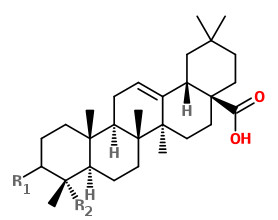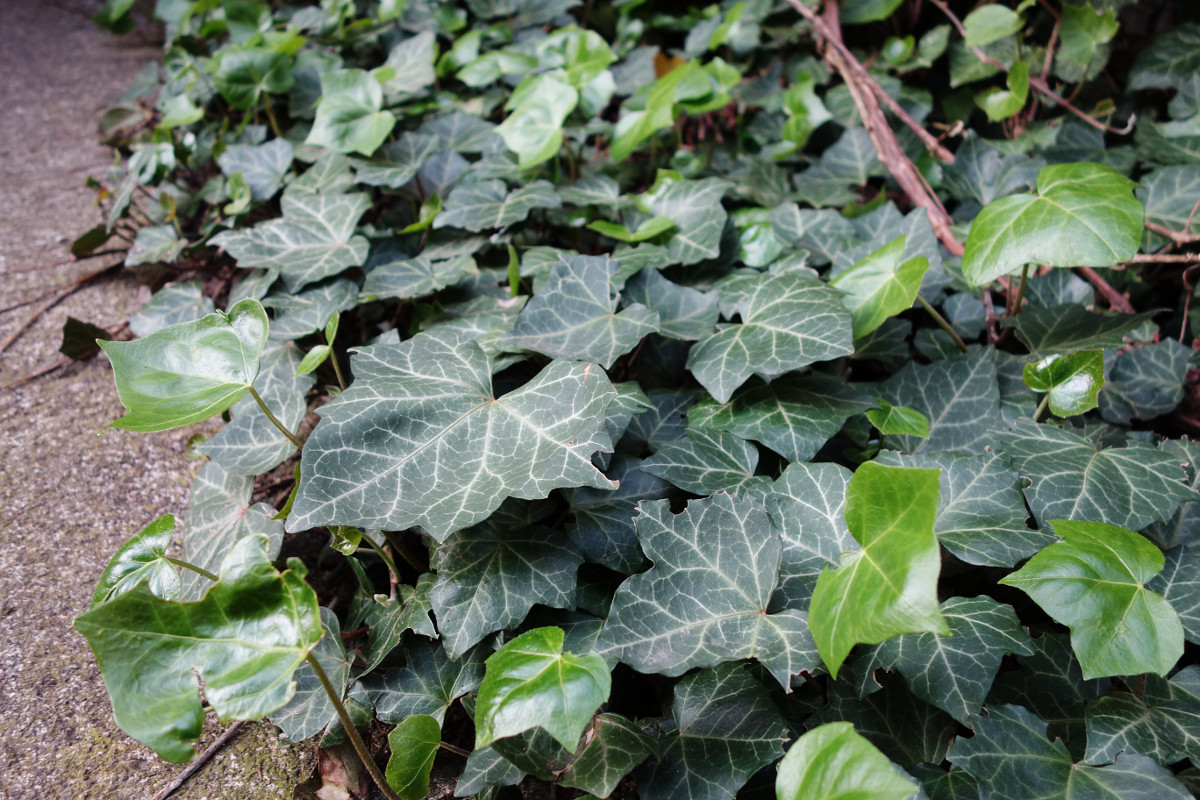Hedera helix L. - Araliaceae - common ivy, English ivy, (Gemeiner) Efeu
Evergreen woody climber, native to Europe, the Mediterranean, and West Asia, widely cultivated as an ornamental; leaves alternate, simple, ovate (on creeping and climbing stems) to palmately five-lobed (flowering stems exposed to full sun); flowers yellow.
Extracts of leaves are used in bronchial diseases, including spasmodic cough. The extract has expectorant and antispasmodic properties. Higher doses may be irritant to mucosa and skin.
[http://de.wikipedia.org/wiki/Gemeiner_Efeu]
„The leaves can cause severe contact dermatitis in some people. People who have this allergy (strictly a Type IV hypersensitivity) are also likely to react to carrots and other members of the Apiaceae as they contain the same allergen, falcarinol.“
http://en.wikipedia.org/wiki/Hedera_helix
„Phytochemical analysis of ivy can comprise a wide range of compounds such as bidesmodic triterpene saponines (e.g.hederacoside C, α-hederin), volatile oil (e.g. methylethylketone), polyines (e.g. falcarinol), steroids (e.g. β-sitosterol), phenols (e.g. rosmarinic acid), and flavonoids (e.g. rutin)…
α-Hederin amounts in younger flowering branch leaves were remarkably higher than in older ones, in B2, [it] was found in 1.62% whereas in B1 it was only 0.18%. Non-flowering branch leaves (B3) contained hederacoside C in 6.53%, which was found in flowering branch leaves (B1) in 4.72% amount, α-hederin was not detected in B3.“
[HPLC profiling and quantification of active principles in leaves of Hedera helix L., Demirci, B., Goppel, M., Demirci, F., Franz, G., Die Pharmazie - An International Journal of Pharmaceutical Sciences, Vol.59(10), 2004, 770-774]
„Common ivy contains up to 10% saponins such as α- and β-hederin. Hederin is a strong irritant to the mucosal surfaces of the nose and throat. As mentioned above, the polyacetylenic compounds falcarinol and didehydrofalcarinol detected in stalks, leaves, and roots of common ivy may cause both irritant and allergic contact dermatitis. The leaves commonly contain more than 1% of the sensitizer which explains the risk of developing irritant contact dermatitis…
During a 16-year period from May 1993 to May 2009, 127 persons, including controls, were patch tested with falcarinol and 10 tested positive.“
[Dermatitis from common ivy (Hedera helix L. subsp. helix) in Europe: past, present, and future., Paulsen, E., Christensen, L.P., Andersen, K.E., Contact dermatitis, Vol.62(4), 2010, 201-209]
 α-hederin (R1=Rha1→2Ara-; R2=CH2OH); β-hederin (R1=6-deoxy-Man2→3Ara-; R2=CH3)
α-hederin (R1=Rha1→2Ara-; R2=CH2OH); β-hederin (R1=6-deoxy-Man2→3Ara-; R2=CH3)
„Preparations of ivy leaves dry extract with secretolytic and bronchiolytic efficacy are widely used for the treatment of acute and chronic obstructive airway diseases. The mechanism by which ivy preparations improve lung functions is not fully understood. Here, we tested the influence of the three main saponins of ivy, α-hederin, hederacoside C and hederagenin, on the contraction and relaxation behaviour of isolated bovine tracheal smooth muscle strips by isometric tension measurements. None of the tested compounds altered histamine or methacholine-induced contraction of the smooth muscle strips. In contrast, the isoprenaline-induced relaxation of 100 μM methacholine precontracted muscle strips was significantly enhanced when pre-treated with 1 μM of α-hederin for 18 h. The pre-treatment with hederacoside C or hederagenin had no effect on isoprenaline-induced relaxation. For the first time the bronchiolytic effect of α-hederin was demonstrated by isometric tension measurements using bovine tracheal smooth muscle strips. α-Hederin increases isoprenaline-induced relaxation indirectly, probably by inhibiting heterologous desensitization induced by high concentrations of muscarinic ligands like methacholine.“
[Pre-treatment with α-hederin increases β-adrenoceptor mediated relaxation of airway smooth muscle., Wolf, A., Gosens, R., Meurs, H., Häberlein, H., Phytomedicine, 18(2), 214-218.]
Oral administration of hederacoside C to rats results in a low absolute oral bioavailability of 0.118–0.250%. This extremely bioavailabilty may be due to poor absorption from the gastrointestinal tract and/or its decomposition therein.
[Pharmacokinetics of hederacoside C, an active ingredient in AG NPP709, in rats., Kim, J.M., Yoon, J.N., Jung, J.W., Choi, H.D., Shin, Y.J., Han, C.K., Kang, H.E., Xenobiotica, Vol.43(11), 2013, 985-992]
The ethanolic extract was tested for its antiinflammatory properties on rat paw edema. „Intraperitoneal injections of 7.5 ml/kg wt ethanol extract showed antiinflammatory activity with 88.89% inhibition as compared to reference drug diclofenac, which showed 94.44% inhibition in formalin-induced paw oedema.“
[The antiinflammatory and antiarthritic properties of ethanol extract of Hedera helix., Rai, A., Indian journal of pharmaceutical sciences, Vol.75(1), 2013, 99]
http://www.ncbi.nlm.nih.gov/pmc/articles/PMC3719157/
„The effect of ivy leaves dry extract is based on its secretolytical and broncholytical properties. The main active compounds are saponins (Cioacá et al., 1978, Trute et al., 1997 and Bedir et al., 2000), especially α-hederin represents the most important saponin molecule responsible for the therapeutic effect (Sieben et al. 2009). α-Hederin inhibits the internalization of the β2-receptor leading to an increased adrenergic accessibility of the cells. Subsequently, type II alveolar epithelial cells generate more surfactant yielding to the secretolytic activity by reduction of the mucus viscosity. Similarly, the bronchodilating effect can be related to the increased β2-adrenergic activity resulting in a higher sensitivity to spasmolytics such as adrenalin, the strongest physiological bronchodilator (Hegener et al. 2004). In a double blind comparative study against Ambroxol, the ivy leaves dry extract demonstrated non-inferiority concerning relevant clinical and lung function outcome parameters (Meyer-Wegener et al. 1993).
… children with mild uncontrolled asthma despite regular inhaled corticosteroid therapy might benefit from an additional therapy with ivy leaves dry extract. However, further studies are needed.“
[Tolerance and effect of an add-on treatment with a cough medicine containing ivy leaves dry extract on lung function in children with bronchial asthma., Zeil, S., Schwanebeck, U., Vogelberg, C., Phytomedicine, Vol.21(10), 2014, 1216-1220]
http://www.sciencedirect.com/science/article/pii/S094471131400227X
„The bronchospasmolytic and secretolytic effects of ivy leaves dry extracts can be explained by an increased β2-adrenergic responsiveness of the bronchi. Recently, it was shown that α-hederin inhibits the internalization of β2-adrenergic receptors (ß2AR) under stimulating conditions. α-Hederin pretreated alveolar type II cells and human airway smooth muscle cells revealed an increased ß2AR binding and an elevated intracellular cAMP level, respectively…
In order to identify whether additional compounds also mediate an increased β2-adrenergic responsiveness, we examined the ingredients of an ivy leaves dry extract (EA 575) protocatechuic acid, neochlorogenic acid, chlorogenic acid, cryptochlorogenic acid, rutin, kaempferol-3-O-rutinoside, 3,4-, 3,5- and 4,5-dicaffeoylquinic acid, hederacoside B, and β-hederin. Within all the tested substances, only β-hederin inhibited the internalization of GFP-tagged ß2AR in stably transfected HEK293 cells. Using fluorescence correlation spectroscopy β-hederin (1 μM, 24 h) pretreated HASM cells showed a statistically significant increase in the ß2AR binding… Within this systematic study focusing on the influence of the ingredients of an ivy leaves dry extract on HASM cells it was possible to identify β-hederin as further component presumably responsible for the β2-mimetic effects.“
[A systematic study on the influence of the main ingredients of an ivy leaves dry extract on the β 2-adrenergic responsiveness of human airway smooth muscle cells., Greunke, C., Hage-Hülsmann, A., Sorkalla, T., Keksel, N., Häberlein, F., Häberlein, H., Pulmonary pharmacology & therapeutics, 2014]
http://www.sciencedirect.com/science/article/pii/S1094553914001114
„… hederagenin has been shown to possess anti-nociceptive and anti-inflammatory properties in mice, and ivy extracts are commonly used in natural medicine to treat rheumatoid arthritis… [hederagenin is] a novel and selective antagonist at the NPFFR1. Through comprehensive analysis, its binding mode at the NPFFR1 and critical residues that contribute to the selectivity of the antagonist over NPFFR2 have been determined.“
[Lentschat, Hannah, et al. „Hederagenin is a Highly Selective Antagonist of the Neuropeptide FF Receptor 1 that Reveals Mechanisms for Subtype Selectivity.“ Angewandte Chemie (2024): e202417786]

Lindman, C.A.M., Bilder ur Nordens Flora, vol.2, t.249 (1922-1926)

Hedera helix leaves CC BY-SA 3.0, Author: Andreas Kraska
